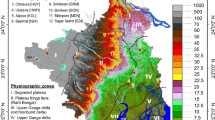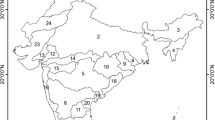Abstract
Monthly rainfall data, spanning over 110 years (1901–2010), were utilized for trend analysis at different spatial and temporal scales over the Brahmaputra valley, India. The Mann–Kendall statistic and Sen’s slope model were used to identify the trends and estimate the magnitude of change, respectively. Statistical significance of the decadal shifts in rainfall from the overall mean was estimated by using Cramer’s test. The analysis revealed decrease in annual as well as monsoon rainfall in the Brahmaputra valley during the last 110 years with large spatial and temporal variations. These decreasing trends of rainfall in the eastern part of the valley were statistically significant. Significant decreasing trend of monsoon rainfall during the recent 30-year period was due to significant decrease of July and September rainfall, and this trend was found to be consistent at different spatial scales. In the last decade (2001–2010) in particular, monsoon rainfall exhibited significant negative deviation from the normal due to three deficient years and absence of excess rainfall years. On the contrary, contribution of pre-monsoon and post-monsoon rainfall to annual total in the Brahmaputra valley increased during the recent 30-year period. Winter rainfall in the valley decreased during the last 30 years due to significant decrease of December rainfall in the eastern and central parts.







Similar content being viewed by others
References
Ajayamohan RS, Merryfield WJ, Kharin VV (2010) Increasing trend of synoptic activity and its relationship with extreme rain events over central India. J Climate 23:1004–1013
Attri SD, Tyagi A (2010) Climate profile of India. IMD Met Monograph No. Environ Meteorol-01/2010. pp 3–4
Barthakur M (2004) Weather and climate. In: Singh VP et al (eds) The Brahmaputra Basin water resources. Kluwer Academic Publishers, The Netherlands, p 22
Bollasina MA, Ming Y, Ramaswamy V (2011) Anthropogenic aerosols and the weakening of the South Asian summer monsoon. Science 334:502–505
Chakrabarti D, Biswas HR, Das GK, Kore PA (2008) Observational aspects and analysis of events of severe thunderstorms during April and May 2006 for Assam and adjoining states—a case study on ‘Pilot Storm Project’. Mausam 59:461–478
Chaudhuri S (2010) Predictability of severe thunderstorms with fractal dimension approach. Asian J Water Air Environ Pollut 7(4):81–87
Chaudhury S, Middey A (2013) Disparity in the characteristic of thunderstorms and associated lightning activities over dissimilar terrains. Meteorol Atmos Phys 119(3–4):151–161. doi:10.1007/s00703-012-0225-4
Das MM (1992) Climatic pattern and agro-climatic regions of Assam. In: Mohammad N (ed) The ecology of agricultural systems. Concept Publishing Company, New Delhi, pp 199–212
Dash SK, Kumar JR, Shekhar MS (2004) On the decreasing frequency of monsoon depressions over the Indian region. Curr Sci 86:1404–1411
Dash SK, Jenamani RK, Kalsi SR, Panda SK (2007) Some evidence of climate change in twentieth-century India. Clim Change 85:299–321
Deka RL, Mahanta C, Pathak H, Nath KK, Das S (2013) Trends and Fluctuations of Rainfall Regime in the Brahmaputra and Barak basins of Assam. India Theor Appl Climatol 114:61–71. doi:10.1007/s00704-012-0820-x
DES (2012) Economic survey of Assam 2011–2012, Directorate of Economics and Statistics, Planning and Development Department, Government of Assam
Dhar ON, Nandargi S (2000) A study of floods in the Brahmaputra basin in India. Intl J Climatol 20:771–781
Dhar ON, Nandargi S (2003) Hydrometeorological aspects of floods in India. Nat Hazards 28:1–33
Dhar ON, Mandal BN, Rakhecha PR (1984) Rainfall distribution over India during the monsoon months in the absence of depressions and cyclonic storms. Mausam 35(3):309–314
Ghosh S, Dutta S (2012) Impact of climate change on flood characteristics in Brahmaputra basin using a macro-scale distributed hydrological model. J Earth Syst Sci 121(3):637–657
Gilbert RO (1987) Statistical methods for environmental pollution monitoring. Van Nostrand Reinhold, New York
Goswami DC (1985) Brahmaputra River, Assam, India: physiography, basin denudation and channel aggradation. Water Resour Res 21(7):957–978
Goswami BB, Mukhopadhyay P, Mahanta R, Goswami BN (2010) Multiscale interaction with topography and extreme rainfall events in the northeast Indian region. J Geophys Res 115:D12114. doi:10.1029/2009JD012275
Guhathakurta P, Rajeevan M (2008) Trends in the rainfall pattern over India. Int J Climatol 28:1453–1469
Guhathakurta P, Sreejith OP, Menon PA (2011) Impacts of climate change on extreme rainfall events and flood risk in India. J Earth Syst Sci 120(3):359–373
Hamed KH (2008) Trend detection in hydrologic data: the Mann-Kendal trend test under the scaling hypothesis. J Hydrol 349:350–363
Helsel DR, Hirsch RM (1992) Statistical methods in water resources. Elsevier, Amsterdam
Hirsch RM, Slack JR, Smith RA (1982) Techniques of trend analysing for monthly water quality data. Water Resour Res 18:107–121
Hulme M (1995) Estimating global changes in precipitation. Weather 50:34–42
IMD (2006, 2007) Southwest monsoon—end of season report for 2006 and 2007. IMD (India Meteorological Department), New Delhi (http://www.imd.ernet.in)
Jadav SK, Munot AA (2009) Warming SST of Bay of Bengal and decrease in formation of cyclonic disturbances over the Indian region during southwest monsoon season. Theor Appl Climatol 96:327–336
Jain SK, Kumar V (2012) Trend analysis of rainfall and temperature data for India. Curr Sci 102(1):37–49
Kendall MG (1975) Rank correlation methods. Griffin, London
Kripalani RH, Kulkarni A, Sabade SS, Khandekar ML (2003) Indian monsoon variability in a global warming scenario. Nat Hazards 29:189–206
Kulkarni A (2012) Weakening of Indian summer monsoon rainfall in warming environment. Theor Appl Climatol 109:447–459
Kumar V, Jain SK, Singh Y (2010) Analysis of long-term rainfall trends in India. Hydrol Res 55:484–496
Letcher T (2009) Climate change: observed impacts on recent planet earth. Elsevier, The Netherlands, pp 1–400
Mandke SK, Bhide VU (2003) A study of decreasing storm frequency over Bay of Bengal. J Ind Geophys Union 7(2):53–58
Mann HB (1945) Non-parametric tests against trend. Econometrica 13:245–259
Mirza MMQ, Warrick RA, Ericksen NJ, Kenny GJ (1998) Trends and persistence in precipitation in the Ganges, Brahmaputra and Meghna basins in South Asia. Hydrol Sci J 43(6):845–858
Mooley DA, Parthasarathy B (1984) Fluctuations of all India summer monsoon rainfall during 1871–1978. Clim Change 6:287–301
Pant GB, Rupa Kumar K (1997) Climates of South Asia. Wiley, Chichester, p 320
Partal T, Kahya E (2006) Trend analysis in Turkish precipitation data. Hydrol Proc 20:2011–2026
Pathak H (2000) A review of influence of the major factors associated with weather over NE India. National seminar ‘Role of coupling process between earth near earth parameters and biosphere’. 16–18 January, 2000, Gauhati University, Assam India
Pathak B, Bhuyan PK (2012) Relationship between aerosol and rainfall over North East India: spatial variability. Proceedings of International conference on Opportunities and Challenges in Monsoon Prediction in a Changing Climate (OCHAMP-2012), Pune India
Pattanaik DR (2007) Analysis of rainfall over different homogeneous regions of India in relation to variability in westward movement frequency of monsoon depressions. Nat Hazards 40:635–646
Ramesh Kumar MR, Krishnan R, Sankar S, Unnikrishnan AS, Pai DS (2009) Increasing trend of break monsoon conditions over India-Role of ocean–atmosphere processes in the Indian Ocean. IEEE Geosci Remote Sens Lett 6(2):332–336
Ranade A, Singh N, Singh HN, Sontakke NA (2008) On variability of hydrological wet season, seasonal rainfall and rain water potential of the river basins of India (1813–2006). J Hydrol Res Dev 23:79–108
Sarma JN (2004) An overview of the Brahmaputra river system. In: Singh VP et al (eds) The Brahmaputra Basin water resources. Kluwer Academic Publishers, The Netherland, pp 72–88
Sen PK (1968) Estimates of the regression coefficient based on Kendall’s tau. J Am Stat Assoc 63:1379–1389
Sen Roy S, Balling JR (2004) Trends in extreme daily precipitation indices in India. Intl J Climatol 24:457–466
Sen AR, Biswas AK, Sanyal DK (1966) The influence of climatic factors on the yield of tea in the Assam valley. J Appl Meteorol 5:789–800
Shahid S (2012) Trends in extreme rainfall events of Bangladesh. Theor Appl Climatol 104:489–499
Sikka DR (2006) A study on the monsoon low pressure systems over the Indian region and their relationship with drought and excess monsoon rainfall, Centre for Ocean-Land-Atmosphere Studies. Centre for the Application of Research on the Environment, Calverton
Singh GP, Oh J (2007) Impact of Indian Ocean sea-surface temperature anomaly on Indian summer monsoon precipitation using a regional climate model. Intl J Climatol 27:1455–1465
Singh N, Sontakke NA (2002) On climate fluctuations and environmental changes of the Indo Gangetic plains in India. Clim Change 52:287–313
Sinha Ray KC, De US (2003) Climate change in India as evidenced from instrumental records. WMO Bull 52:53–58, World Meteorological Organization, Geneva, Switzerland
Thapliyal V, Kulshrestha SM (1991) Climate changes and trends over India. Mausam 42:333–338
Trenberth KE, Jones PD, Ambenje P et al (2007) Observations: surface and atmospheric climate change. In: Solomon S, Qin D, Manning M (eds) Climate Change 2007: the physical science basis. Contribution of Working Group I to the Fourth Assessment Report of the Intergovernmental Panel on Climate Change. Cambridge University Press, Cambridge
Turner AG, Annamalai H (2012) Climate Change and South Asian Summer Monsoon, Nature Climate Change, online publication June 24
WMO (1966) Climate change WMO Tech. Note, No.79, WMO No. 195-TP-100., Geneva 80
WMO (1989) Calculation of monthly and annual 30-year standard normals. WCDP, No.10, WMO–TD/No.341, Geneva
Yamane Y, Hayashi T (2006) Evaluation of environmental conditions for the formation of severe local storms across the Indian subcontinent. Geophys Res Lett 33, L17806. doi:10.1029/2006GL026823
Acknowledgments
Authors are grateful to the India Meteorological Department (IMD), Pune and Regional Meteorological Centre, Guwahati, Assam for providing the data used in this study. Authors are also grateful to the anonymous reviewer for the critical review, which helped in improving the quality of the paper.
Author information
Authors and Affiliations
Corresponding author
Rights and permissions
About this article
Cite this article
Deka, R.L., Mahanta, C., Nath, K.K. et al. Spatio-temporal variability of rainfall regime in the Brahmaputra valley of North East India. Theor Appl Climatol 124, 793–806 (2016). https://doi.org/10.1007/s00704-015-1452-8
Received:
Accepted:
Published:
Issue Date:
DOI: https://doi.org/10.1007/s00704-015-1452-8




